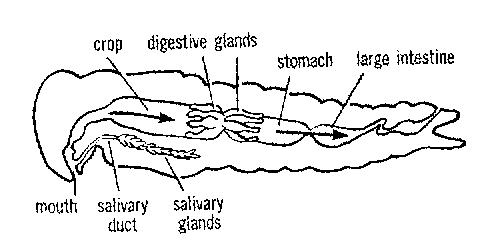Chapter
8 - Nutrition
8-1 The Process of Nutrition
autotrophic nutrition
- makes organic
compounds
from
inorganic
materials
- "autotrophs":
most plants
some monerans
protists (including all
algae)
- two types:
photosynthesis -most
common
chemosynthesis
heterotrophic nutrition
- can NOT make organic
compounds
from
inorganic
materials
-must obtain organic
materials
from other
living
organisms or their
products
- "heterotrophs":
all animals
most fungi, protozoans,
and bacteria
HUMAN NUTRITIONAL NEEDS
ENERGY CONTENT OF
FOOD
8-2 Adaptations for Nutrition
and
Digestion
HETEROTROPHIC NUTRITION
1. Ingestion
- taking
in food from
environment
2. Digestion
- break
down of insoluble
or large food molecules
into smaller, soluble
molecules so they can
pass through cell
membrane
- extracellular
- if
digestion occurs
outside of cell
- intracellular
- food
enclosed inside
vacuoles in cells,
then digested
- end
products diffuse
through membrane
and enter cytoplasm
a. Physical
Changes -
cutting, grinding,
tearing into smaller
pieces
- this increased surface
area so chemical
agents can work better
b. Chemical
Changes
- food broken down
chemically with
digestive enzymes
- produces soluble
end products
|
|
|
| carbohydrates | simple sugars (monosaccharides) |
| lipids (fats, oils) | fatty acids and glycerol |
| proteins | amino acids |
3. Egestion
-removal or elimination
of undigested or
indigestible materials
- different from
excretion, which is
removal of waste
products produced by
metabolic activities
Fungi
-heterotrophs
-food supply may be living
organisms or the decaying
remains of organisms
Adaptations:
1. rhizoids-filaments
which
penetrate food source
2. digestive enzymes are
secreted
by the rhizoids
causing
extracellular
digestion;
digested
nutrients
then absorbed
into
cells of the rhizoids
NUTRITION OF
REPRESENTATIVE
ORGANISMS
paramecium
[see Fig. 8-8, p 156 Tiger
Book]
1. Ingestion
- by motion of cilia
- ingests food through
opening at base of
oral groove
2. Digestion
- food ingested in food
vacuole that forms at
the base of oral
groove
- merges with lysosomes
which contains
digestive enzymes
- end products absorbed
into cytoplasm
3. Egestion
- undigested
material in
food vacuole is carried
to anal pore, released
to environment
ameba
[see Fig. 8-7, p 156 Tiger
Book]
1. Ingestion
- surrounds
food with
pseudopods
- merge
and enclose food
in a food vacuole
(called phagocytosis)
2. Digestion
- occurs
in food vacuole
- absorption
occurs in
food vacuole
- food
vacuole merges
with lysosomes
(as with paramecium)
3. Egestion
- undigested
material in
food vacuole is
released when
vacuole touches cell
membrane
- forms
an opening and is
released to outside
hydra
[see Fig. 8-9, p 157 Tiger
Book]
1. Ingestion
- has
sac-type digestive
cavity, with single
opening
- food
ingested through
this opening
- tentacles
help
manipulate
2. Digestion
extracellular
(outside of cell)
- cells line cavity that
secrete enzymes
intracellular
(inside of cell)
- occurs in cells in the
inner lining of cavity
- food is engulfed by
phagocytosis
- food is digested
intracellularly
3. Egestion
- undigested
material is
released through the
same opening it was
ingested through
earthworm
[see Fig. 8-11, p 158 Tiger
Book]
1. Type of Digestive System
- one-way,
tube-like
- opening
at each end
- food
passes through
specialized organs
2. Organs
- food
ingested through
mouth and esophagus
-
stored temporarily in
crop
- enters
gizzard
-
mechanical
breakdown occurs here
- chemical
digestion
occurs in the intestine,
end products are
absorbed here
- undigested
materials
egested through the
anus
Fig. 3 - earthworm digestion
grasshopper
[see Fig. 8-12, p 159 Tiger
Book]
1. Type of Digestive System
- tube-like
- similar
to earthworm
2. Auxiliary Organs
- food
broken down
mechanically by mouth
parts
-also
has gastric caeca,
which secretes digestive
enzymes into tract for
chemical digestion
Fig. 4 - grasshopper digestion

THE ESOPHAGUS
1. structure.
-muscular tube
that
connects mouth
to
stomach
2. function.
-swallowing moves
food
into esophagus
-Peristalsis of
muscular
walls moves food down
to stomach
THE STOMACH
1. structure.
-muscular sac
- lining contains
gastric
glands
- glands
secrete
enzymes and
hydrochloric acid (HCl)
(Gastr-Greek refers to belly)
2. function.
-mix food with
digestive
juices
-enzyme gastric
protease
begins digestion of
protein
-HCl provides proper
pH
THE SMALL INTESTINE
[see Fig. 8-16, p 164 Tiger
Book]
1. structure.
-long,
coiled tube of
small diameter
-lining
contains intestinal
glands
-glands
secrete digestive
enzymes into intestine
-partially
digested food
enters from stomach
2. Accessory functions.
a. -liver secretes
bile
-bile stored in gall
bladder, passes
through duct into the
intestine
b.pancreas
secretes
pancreatic juice
3.Digestive functions.
a. bile- mechanically
breaks down fats into
small droplets
b. pancreatic juice-
contains proteases,
lipases (digest lipids),
and amylases
c. intestinal
juice-
contains proteases,
lipases, and
disaccharidases
(digests disaccharides;
e.g. maltase digests
"maltose"--a disaccharide)
4. Absorption.
a. Structures for absorption.
villi-along
lining (s. villus)
-increase the surface
area of small intestine
-most absorption
occurs through villi
walls
-inside each villus are
lacteals-small vessels
of the lymphatic
system--and
cappillaries of the
circulatory system.
b. Absorption of end
products of digestion
(1) Fatty acids and gylcerol
-absorbed through the
villi into the
lacteals
-transported by the lymph
to the circulatory
system
(2) Monosaccharides and
amino acids
-absorbed through
villi
into cappillaries
-transported by
blood to
liver, where stored
until needed
THE LARGE INTESTINE
1. structure.
-tube of large
diameter,
much shorter that sm.
intestine
-undigested food
passes
here from sm. intestine
2. functions.
-excess water is
absorbed here
-wastes are moved
by
peristalsis into rectum
-these semi-solid
wastes
are called feces
-feces is
egested
through an opening
called anus
CHEMICAL DIGESTION
1. Organs &their secretions.
[see HANDOUT-"SECRETIONS
OF THE
HUMAN DIGESTIVE
SYSTEM."]
2. Hydrolysis.
-breaking
large
molecules down to
smaller molecules by
addition of water
-most
digestion occurs
by this process
-reverse
of dehydration
synthesis
3. Polysaccaride digestion.
-digestive
enzymes break
them
down into simple
sugars,
such as glucose,
by hydrolysis
4. Digestion of proteins.
-broken
down by
digestive enzymes into
amino acids by
hydrolysis of peptide
bond
5.Digestion of lipids (fats).
- digestive
enzymes
called
lipases break into
fatty
acids and glycerol
by hydrolysis